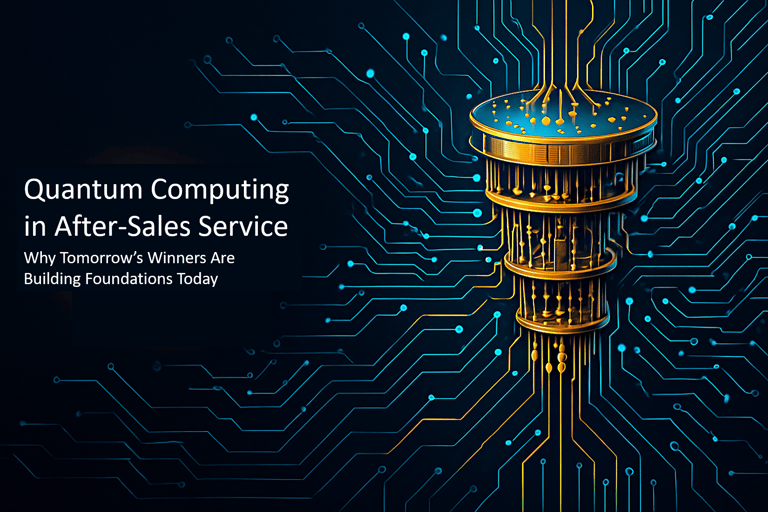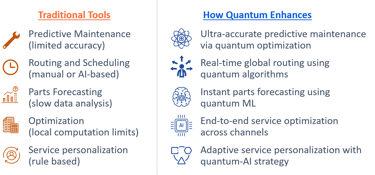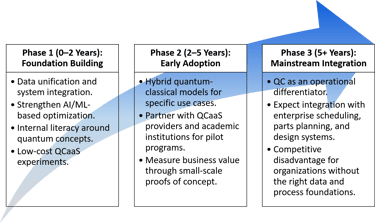Quantum Computing in After-Sales Service: Why Tomorrow's Winners Are Building Foundations Today
Mihir Joshi


Quantum computing is having its moment. In Q1 2025, the industry raised over $1.25 billion, more than double the previous year. Governments are making billion-dollar bets: Australia committed $620 million, Japan announced $7.4 billion, and Illinois invested $500 million.
Then came the reality check. Nvidia CEO Jensen Huang said quantum computing is “15 to 30 years away” from being truly useful. Quantum stocks dropped overnight. However, both views are right. Quantum breakthroughs are real and long-term potential is transformative but practical impact is still years away.
For after-sales service leaders in manufacturing and automotive, the timeline is roughly 5–10 years before quantum starts influencing day-to-day operations. That creates a paradox: quantum won’t change your operations tomorrow, but organizations building the right foundations now will be far ahead when it does.
Why Tomorrow's Winners Are Building Foundations Today


Quantum Computing in After-Sales Service
Understanding Quantum Computing: Beyond the Hype
Classical computers process information using bits that are either 0 or 1. They evaluate options sequentially or in batches, following logical steps from start to finish. They're extraordinarily good at this, which is why they've powered decades of digital transformation.
Quantum computers operate fundamentally differently. They use qubits, which can exist in multiple states simultaneously through a phenomenon called superposition. This allows quantum computers to explore millions of potential solutions at once, making them extraordinarily effective for specific types of problems, particularly optimization, simulation, and pattern recognition challenges that involve massive numbers of variables and constraints.
This isn't about having "faster computers." It's about solving certain classes of problems in fundamentally different ways.
The technology is still early. The global quantum computing market is around $1 billion today, projected to reach $8.6 billion by 2030 and $45 billion by 2035. Google’s Willow processor showed progress in reducing error rates, but challenges remain: qubit stability, error correction, scalability, and integration.
Think of quantum in 2025 like AI in 2016 - real, exciting, but not production-ready. For after-sales service specifically, it is expected to take 5-10 years before quantum creates measurable business impact. This timeline isn't pessimistic, it's realistic. And it's precisely why strategic preparation matters now.
Where Quantum Computing Could Transform After-Sales Service
Quantum won’t revolutionize every process. But in areas where classical computing hits its limits, the advantages could be game-changing.
Ultra-Complex Scheduling & Resource Optimization
Large field service operations juggle thousands of technicians, each with unique skills, certifications, time zones, and priorities, plus real-time parts data, weather, and traffic. Classical algorithms can solve this, but large recalculations often take 30–60 minutes.
Quantum optimization could bring that down to seconds.
Example: Volkswagen already uses quantum algorithms for fleet routing and traffic management—directly applicable to field service logistics.
Impact: Faster response in disruption scenarios (like severe weather or recalls) could translate into millions in efficiency gains and stronger SLA performance.


Predictive Maintenance and Hidden Correlations
Most machine learning models analyze 10–15 parameters, predicting failures about a week in advance. Quantum could analyze 100+ variables simultaneously, potentially extending prediction windows to 30+ days.
With longer prediction windows, manufacturers could:
Strategically position parts and technicians in advance.
Schedule repairs during planned downtime.
Reduce unplanned downtime by 20–30%.
Caution: This only works if sensor data is complete, structured, and integrated. Quantum can’t fix bad data, it will only amplify the noise.
From binary to quantum: shifting from sequential logic to probabilistic insight, redefining how industries solve complex problems and deliver value
Inventory and Parts Network Optimization
Parts availability is the single biggest driver of after-sales satisfaction. Optimizing across multi-echelon networks- warehouses, service centers, and technician vehicles is notoriously difficult.
Classical algorithms often optimize one location at a time due to computational limits. Quantum could optimize entire networks simultaneously, factoring in probabilistic demand, supply uncertainty, and dynamic rebalancing.
Even a 5% improvement in both availability and carrying cost could yield hundreds of millions in annual impact for global parts businesses.
Materials Science for More Reliable Parts
Quantum isn’t limited to algorithms. It can simulate materials at a molecular level to improve reliability.BMW, for instance, is partnering with Pasqal to use quantum simulation for component design and material optimization, reducing warranty costs and extending product life.
A 10% reduction in warranty claims on a $500 million parts business equates to $50 million annually, plus higher customer satisfaction and lower service center load.
The Reality Check: Are You Quantum-Ready?
Before thinking quantum, organizations must ask:
Can we optimize routes for 500+ technicians in under 10 minutes using current tools?
Is our IoT and service data clean, structured, and integrated?
Do we have unified data architecture linking service, parts, and customer history?
Can we quantify the business impact of a 5% efficiency gain?
If the answer to any of these is no, quantum isn’t the next step - data and classical optimization are.
The 90/10 principle applies: if classical systems can deliver 90% of potential gains, the remaining 10% from quantum won’t justify investment yet.
Still, there’s value in experimentation. Cloud-based Quantum Computing-as-a-Service (QCaaS) platforms from IBM Quantum, AWS Braket, and Azure Quantum let organizations explore use cases without major capital spend.
According to McKinsey's research, the finance sector is leading quantum exploration (28% of organizations actively investigating), followed by energy and materials (16%), and telecommunications (16%). Industrial manufacturers are largely still in the education and exploration phase, but that's changing rapidly
Building the Foundation: What Smart Leaders Are Doing
You can’t deploy quantum at scale yet but you can prepare your organization to move fast when the time comes.
Build Data Architecture Excellence
Unify service, parts, customer, and equipment data in real time. Invest in strong data governance and quality processes. Create pipelines that connect IoT sensors to analytics and decision systems.
This is non-negotiable for quantum readiness.
Master Classical Optimization
Focus on squeezing full value from AI and machine learning first. Build digital twins, deploy predictive maintenance models, and optimize scheduling.
The manufacturers advancing in quantum (VW, BMW, Honeywell) all share one thing: they mastered the fundamentals before experimenting.
Build Quantum-Aware Leadership
You don’t need a quantum lab. You need leaders who understand when quantum adds value. Encourage learning, form academic or vendor partnerships, and foster an experimentation culture.
Identify High-Value Problems
Not every optimization problem needs quantum power. Start by mapping where classical systems hit performance limits and quantify value. For example, “Faster scheduling” isn’t a strategy. “Reducing technician travel by 10% saves $8 million annually” is.
The Quantum Readiness Roadmap
Quantum transformation isn’t a single leap, it’s a staged evolution. Organizations that build data, optimization, and leadership maturity now will be the ones ready to scale when the technology matures.
The roadmap below outlines a practical journey from foundational readiness to early experimentation and, eventually, full-scale adoption. It’s designed to help service leaders understand what to prioritize at each stage and how to align investments with technological maturity.
Tentative Quantum Readiness Roadmap for Industrial and Automotive Manufacturers


Future Outlook
Quantum computing won’t reshape after-sales operations overnight. But the time to prepare is now. Organizations have three paths:
Ignore it entirely: risk being unprepared when the inflection point arrives.
Chase premature pilots: waste resources on hype without foundational readiness.
Build deliberately: invest in data, optimization, and leadership now to move fast later.
The smart path is the third.
Quantum computing will transform after-sales service, not by replacing what exists, but by expanding what’s possible. The organizations that treat 2025 as their preparation phase will be the ones leading the industry when quantum becomes mainstream.
Most aren’t ready. That’s your opportunity.
Quantum computing in after-sales is just beginning.
What opportunities or challenges do you see ahead?
Let’s discuss.
Author Info
Written by Mihir Joshi
After 15 years working with leading manufacturers, I created SmartServiceOps to share practical insights for the field service industry.
